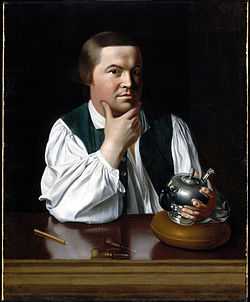Silversmith
A silversmith is a craftsman who crafts objects from silver. The terms "silversmith" and "goldsmith" are not exactly synonyms as the techniques, training, history, and guilds are or were largely the same but the end product may vary greatly as may the scale of objects created. However most goldsmiths have also worked in silver although the reverse may not be the case.
Silversmithing is the art of turning silver sheetmetal into hollowware (dishes, bowls, porringers, cups, candlesticks, vases, ewers, urns, etc.), flatware (silverware), and other articles of household silver, church plate or sculpture. It may also include the making of jewellery.
History
In the ancient Near East the value of silver to gold being less, allowed a silversmith to produce objects and store these as stock. Ogden states that according to anedict written by Diocletian in 301 A.D., a silversmith was able to charge, 75, 100, 150, 200, 250, or 300 denarii for material produce (per Roman pound). At that time, guilds of silversmiths formed to arbitrate disputes, protect its members welfare and educate the public of the trade.[1]
Silversmiths in medieval Europe and England formed guilds and transmitted their tools and techniques to new generations via the apprentice tradition. Silverworking guilds often maintained consistency and upheld standards at the expense of innovation. Beginning in the 17th century, artisans emigrated to America and experienced fewer restrictions. As a result, silverworking was one of the trades that helped to inaugurate the shift to industrialization in America.
In Ethiopia the trade of silversmith was practised by the Jews of Ethiopia, otherwise known as the Falasha Clan. The activity was considered (by whom?) to be inferior to others, as reliant on manual skills.[2]
Tools, materials and techniques

- saw (jeweler's saw)
- snips
- flat file
- jewelers' file
- planishing hammer
- raising hammer
- cross-pein hammer
- ball-pein hammer
- anvils
- stakes
- swage blocks
- riveting
- silver hard-solder
- flux
- torch or blow-pipe
- pickle (Dilute sulphuric acid or organic acids which are used to remove firescale[3])
- buffing wheels
- polishing compounds.
- chasing
- repousse
- engraving
Silversmiths saw or cut specific shapes from sterling and fine silver sheet metal and bar stock, and then use hammers to form the metal over anvils and stakes. Silver is hammered cold (at room temperature). As the metal is hammered, bent, and worked, it 'work-hardens'. Annealing is the heat-treatment used to make the metal soft again. If metal is work-hardened, and not annealed occasionally, the metal will crack and weaken the work.
Silversmiths can use casting techniques to create knobs, handles and feet for the hollowware they are making.
After forming and casting, the various pieces may be assembled by soldering and riveting.
During most of their history, silversmiths used charcoal or coke fired forges, and lung-powered blow-pipes for soldering and annealing. Modern silversmiths commonly use gas burning torches as heat sources. A newer method is laser beam welding.
Silversmiths may also work in copper and brass, although this is usually confined to practice pieces due to the cost of the metals.
Related and overlapping trades

Although jewelers also work in silver and gold, and many of the techniques for working precious metals overlap, the trades of jeweler and Silversmith have distinct histories. Chain-making and gem-setting are common practices of jewelers that are not usually considered aspects of silversmiths.
The tradition of making (iron / plate) armor was interrupted sometime after the 17th century. Silversmithing and goldsmithing, by contrast, have an unbroken tradition going back many millennia. The techniques used to make armor today (whether for movies or for historical recreation groups) are an amalgam of silversmith forming techniques and blacksmith iron-handling techniques.
Canadian observations
In the western Canadian silversmith tradition, guilds do not exist; however, mentoring through colleagues becomes a method of professional learning within a community of craftspersons.[4]
In the Canadian western tradition, silversmithing is done through hand tooling and bright cut engraving of silver. There are silversmiths who only make jewellery and there are silversmiths who only make utensils.[5]
Notable silversmiths

- Jocelyn Burton
- Kurt Aepli
- Garrard & Co
- Georg Jensen
- Benvenuto Cellini
- Georges Cuyvers
- Paul Revere, Colonial-American silversmith, manufacturer, and patriot
- Robert Welch
- Jean-Valentin Morel, French jeweler and craftsman
- Thomas Germain
- François-Thomas Germain
- Atsidi Sani (Old Smith in English), the first known Navajo silversmith
- Sequoyah Cherokee silversmith, inventor of the Cherokee syllabary
- Sampson Mordan
- Hester Bateman
References
- ↑ Jack Ogden. Ancient Jewellery. University of California Press, 7 July 1992. Retrieved 10 April 2012.
- ↑ E.J.Van Donzel (Organization United Nations Educational, Scie, Unesco). History of humanity. UNESCO, 2000. Retrieved 10 April 2012.
- ↑ Brain, Charles. "Pickling Notes". The Ganoksin Project. Retrieved 15 June 2013.
- ↑ Kelly McRae. "Trade Secrets". Western Horseman Magazine.
- ↑ Claude Blair. The craft of silversmith. The History of Silver. p. 225. ISBN 1-85501-900-0.
External links
- Society of American Silversmiths
- Jeff Herman's extensive silver restoration and silver care site
- Michigan Silversmiths Guild
- Staatliche Zeichenakademie Hanau (Silversmith)
- Stamped silver button, made 1787 image from Victoria & Albert Museum jewellery collection.
- Gee,G. The silversmith's handbook : containing full instructions for the alloying and working of silver, including the different modes of refining and melting the metal; its solders; the preparation of imitation alloys...(1921.)
- Sampson Mordan British Silversmith
| ||||||||||||||||||||||||
| ||||||||||||||||||||||||||||||||||||||||||||||||||||||